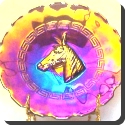 Carnival glass is pressed glass, meaning that hot molten glass which may or may not contain colour of its own is poured into metal moulds and conforms to their shape. While the glass is still hot, various solutions of metallic salts are sprayed onto the surface and the piece is reheated. The result is a piece of iridescent glassware with a rainbow-hued finish. Many pieces of carnival glass feature a distinctive marigold colour with random swirls of other colours strewn throughout the glass. Carnival glass originated as a glass called Iridill, produced in 1908 by the Fenton Art Glass Company. Iridill was inspired by the fine blown art glass of makers like Tiffany and Steuben, but Fenton sold it cheap. They were used as carnival prizes and thus the name.
Carnival glass is pressed glass, meaning that hot molten glass which may or may not contain colour of its own is poured into metal moulds and conforms to their shape. While the glass is still hot, various solutions of metallic salts are sprayed onto the surface and the piece is reheated. The result is a piece of iridescent glassware with a rainbow-hued finish. Many pieces of carnival glass feature a distinctive marigold colour with random swirls of other colours strewn throughout the glass. Carnival glass originated as a glass called Iridill, produced in 1908 by the Fenton Art Glass Company. Iridill was inspired by the fine blown art glass of makers like Tiffany and Steuben, but Fenton sold it cheap. They were used as carnival prizes and thus the name.
Check Also
National Philosophy Day: Date, History, Wishes, Messages, Quotes
National Philosophy Day: This day encourages critical thinking, dialogue, and intellectual curiosity, addressing global challenges …
 Kids Portal For Parents India Kids Network
Kids Portal For Parents India Kids Network






